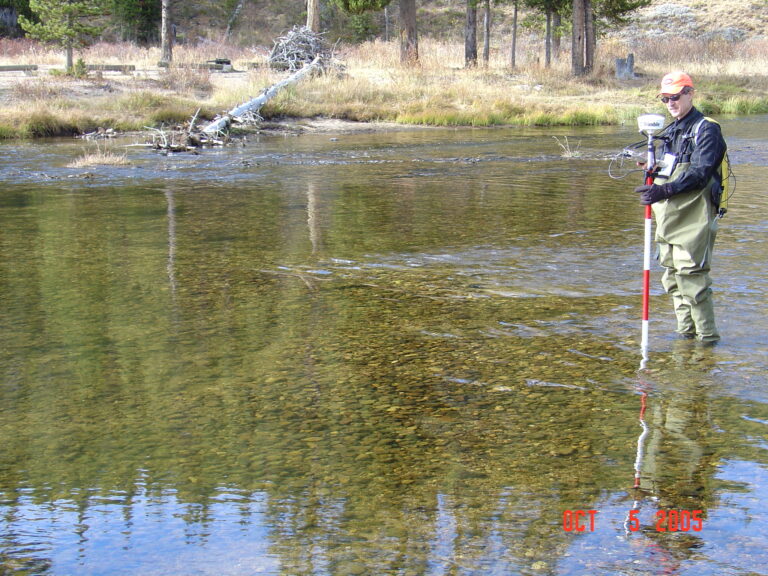forum
library
tutorial
contact

University of Idaho Research Shows Salmon Could
Lose 38% of Spawning Habitat in Bear Valley Creek
by Clark Corbin
Idaho Capital Sun, July 11, 2022
|
the film forum library tutorial contact |

|
University of Idaho Research Shows Salmon Could
by Clark Corbin
|
Study used green lasers to map a critical salmon habitat in Central Idaho
 A new study led by University of Idaho professor Daniele Tonina finds that global warming could reduce Chinook salmon spawning habitat in Bear Valley Creek in Central Idaho by 23% by the year 2040.
A new study led by University of Idaho professor Daniele Tonina finds that global warming could reduce Chinook salmon spawning habitat in Bear Valley Creek in Central Idaho by 23% by the year 2040.
Tonina and other researchers used new green remote sensing lasers to map the streambed along an eight-mile section of Bear Valley Creek, which is a headwater stream of the Salmon River. The researchers selected Bear Valley Creek because it is an important spawning ground for Chinook salmon.
Idaho Chinook are known for their lengthy and perilous migration across the Western United States. After salmon are born in Central Idaho, they must pass through eight dams and travel upstream 900 miles or more to the Pacific Ocean to live. Then, at the end of their lives, they travel another 900 miles back to the waters where they were born to spawn and die.
"One of the key parts of salmon habits is that they require cold waters, clean waters and also very good gravel," Tonina told the Idaho Capital Sun. "They cannot spawn where the water is too warm. They cannot spawn where there is too much sand in it. Those areas that provide those characteristics are very important and need to be protected."
UI professor studies 60 years of historical streamflow data
Based in Boise, Tonina is a professor in the University of Idaho's Center for Ecohydraulics Research within the Department of Civil and Environmental Engineering. The study, "Climate Change Shrinks and Fragments Salmon Habitats in a Snow Dependent Region," was published June 28 in the American Geophysical Union journal Geophysical Research Letters.
Along with the maps of the streambed, Tonina studied 60 years of historical summer streamflow data taken from eight nearby gauges between 1957 and 2016. Researchers used that data supplemented by climate change simulated precipitations to predict river discharge levels through 2090. By 2090, their research projected that 38% of Chinook salmon spawning habitat could be lost.
Tonina said the research covered new ground because the team studied how changes in stream flows over the years, velocity and water depth influence the fish that live there. Tonina said salmon have an incredibly strong homing mechanism that allows them to return to the place where they are born after many years and miles have passed. Those habitats are delicate and require the right cold water conditions for female salmon to lay their eggs.
"It is very important to keep those habitats good, so when they come back, they find the same characteristics that allow the eggs to develop again to keep the cycle going," Tonina said.
What the study found is that going forward, salmon are likely to have decreased stream flows, lower volumes of water and smaller habitat. That could mean that fewer fish could live in that habitat, Tonina said, or it might mean higher density where fish don't grow as large. In some extreme cases, it might even mean some species of salmon might not be viable in some streams and creeks any longer, he said.
Lisa Crozier, a research ecologist at NOAA's Northwest Fisheries Science Center who was not involved in the study, said the research into habitat at Bear Valley Creek offers new insight into habitat loss.
"A huge limitation has been our ability to study the landscape at a scale that's biologically relevant for salmon," Crozier said in a written statement provided by the University of Idaho. "We know the overall pattern is that low flows are bad for fish, but we don't know exactly why or what life stages are most impacted. But here, we can see very specifically they're losing off-channel and spawning habitat. It really helps to know those details."
Tonina, who has studied Bear Valley Creek since 2006, said he hopes the study will raise new awareness how climate change affects salmon habitat and lead to protections of healthy habitat.
learn more on topics covered in the film
see the video
read the script
learn the songs
discussion forum
